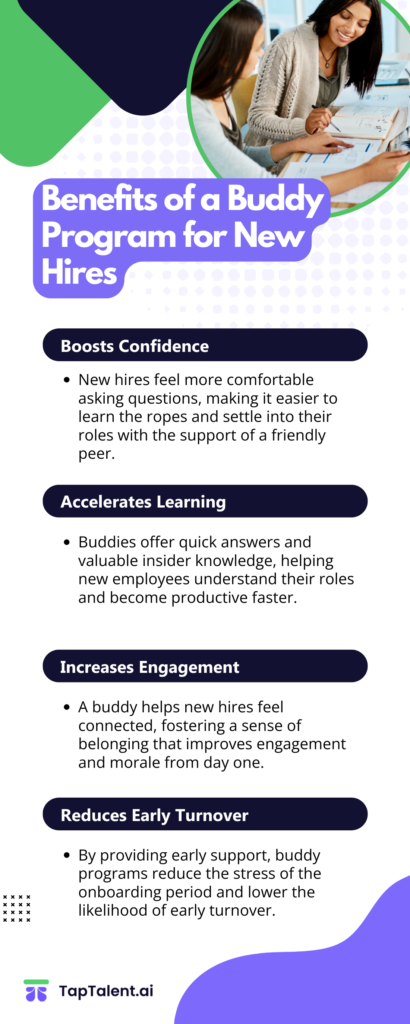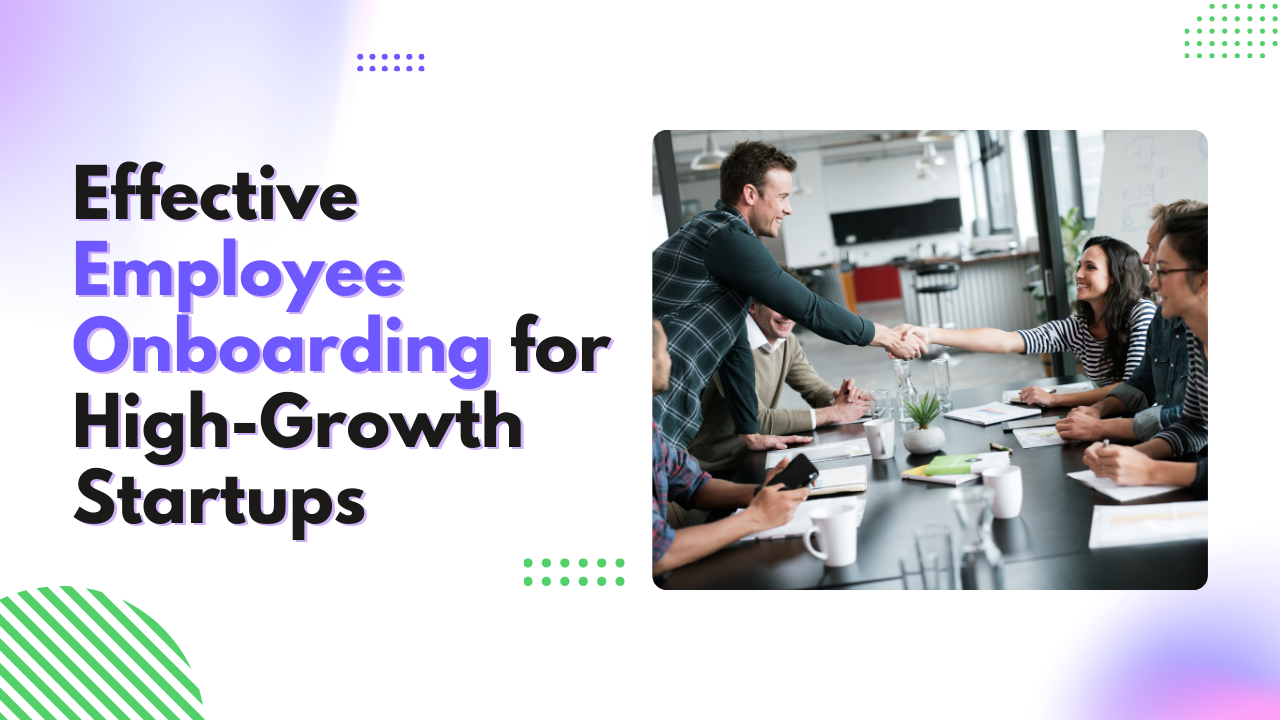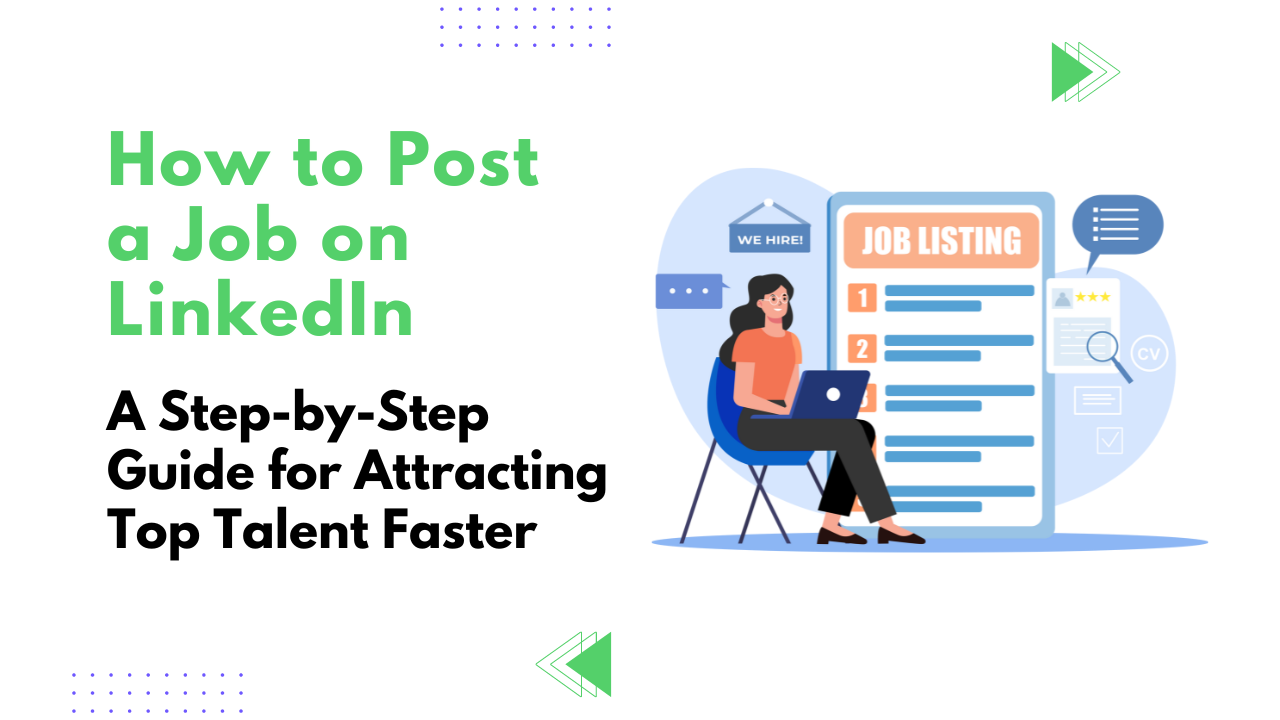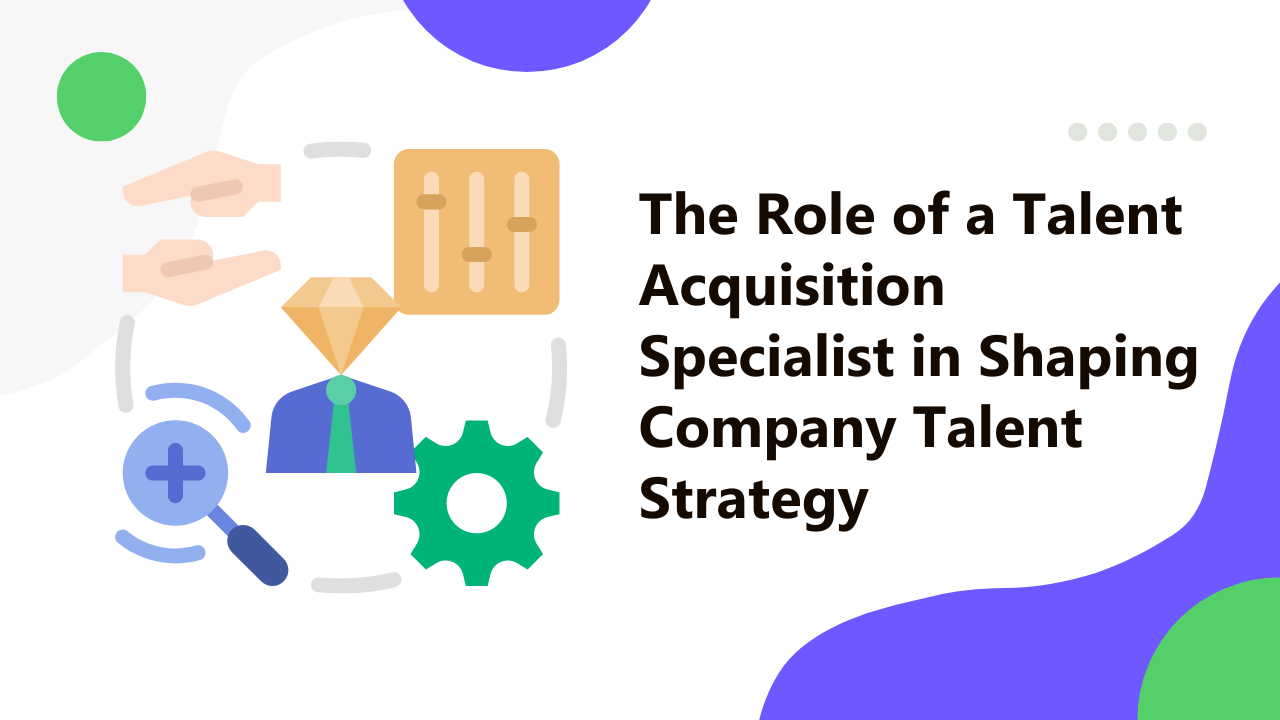Introduction: Why Onboarding Matters for High-Growth Startups
Effective employee onboarding sets the stage for success, especially in high-growth startups where every hire counts. A well-structured onboarding process enhances retention, engagement, and productivity. For example, studies reveal that organizations with strong onboarding processes improve new hire retention by 82% and productivity by over 70%. This guide covers essential onboarding strategies, including pre-onboarding preparation, clear communication, mentorship, and ongoing support, with tools like TapTalent to streamline recruitment and onboarding for sustainable growth.

Employee Onboarding Step 1:
Preparing for Day One: Setting the Foundation
A successful onboarding experience begins long before day one. Preparing early helps new hires feel welcome, informed, and ready to dive in. Here’s how to lay a solid foundation:
Pre-Onboarding Steps
Start engaging with new hires before their first day. Send them a personalized welcome kit with essential items, such as branded merchandise or useful resources. A structured agenda can outline the onboarding week’s activities, while assigning a buddy or mentor provides support and connection right from the start. This early outreach fosters a sense of belonging and excitement.Clear Communication
Transparent communication about job roles, expectations, and company values is essential. Clear information helps new hires align with the organization’s goals and their responsibilities. Additionally, sharing insights on team culture and dynamics gives them context about where they fit within the broader team. By addressing questions early, you reduce anxiety and ensure a smooth start for new hires.
This preparatory phase is fundamental, building both clarity and connection for a positive onboarding experience.
Employee Onboarding Step 2:
Creating a Welcoming First-Day Experience
The first day can set the tone for an employee’s entire journey within your company. For high-growth startups, creating a positive and welcoming experience helps new hires feel valued, engaged, and motivated right from the start. Here’s how to design a memorable and supportive first day:
Virtual and In-Person Welcomes
Whether the new hire is remote or in-person, creating a welcoming environment is key. For remote hires, consider virtual greetings like a video call from the team, a welcome message, or even an online “tour” of the company. For in-person hires, a warm office tour, introductions to team members, and a designated workspace go a long way in making them feel at home. Both approaches foster a sense of belonging and ease any first-day nerves.Meet the Team
Introductions help new hires quickly understand the team dynamic and identify key contacts. Organize meet-and-greet sessions with cross-functional teams, leadership, and immediate teammates. Brief coffee chats or informal lunches allow new hires to build relationships and feel connected to the broader organization. Encourage open communication, allowing them to learn about each person’s role and contributions within the company.Setting Up Essential Tools
Ensuring a smooth day-one transition means providing access to all necessary tools. Create a checklist of essential tools, including email, project management systems, messaging platforms like Slack, and any specialized software relevant to their role. Setting up these tools in advance saves time and avoids delays, letting the new hire focus on acclimating to their responsibilities rather than troubleshooting tech issues.
A well-thought-out first day helps new employees feel confident and valued. By creating an inclusive, supportive environment, startups can improve early engagement, allowing new hires to focus on learning and contributing to their teams.
Employee Onboarding Step 3:
Training for Success
After an engaging first day, it’s time to shift focus to training that will set up new hires for success in their roles. Structured training within the first few weeks provides employees with essential skills, insights, and guidance for thriving in their positions and becoming integrated team members.
Role-Specific Training
The training should begin with an intensive, role-specific focus. Tailored sessions, either through mentoring, self-paced modules, or hands-on projects, help employees gain clarity about their daily responsibilities. This approach ensures that they feel capable, confident, and motivated from the start. When new hires receive customized training that highlights their key tasks, they can better understand where they fit within the larger goals of the company.
Company Culture and Core Values
Transitioning smoothly into a new workplace goes beyond just learning the job. Introducing employees to company culture, mission, and values is crucial to fostering a sense of belonging. Onboarding modules focused on culture and values help employees connect their work to the company’s purpose and goals. By incorporating short, interactive sessions on culture, teams can engage employees early on and convey the unique aspects of the organization’s approach.
Learning and Development Plans
In addition to initial training, it’s effective to implement personalized learning and development plans. These plans outline competencies for the role and set clear, achievable milestones. Breaking down skills and goals by phases, such as the first month or first quarter, provides new hires with a roadmap for growth. Development plans are also instrumental for managers to track progress and offer constructive feedback. Regular check-ins based on these milestones give both the manager and employee insights into how the new hire is progressing, allowing for any adjustments to maximize engagement.
In sum, effective training for new hires is a balance between job-specific skills, cultural alignment, and growth planning. By following a structured training approach, companies set their employees on a path to contribute meaningfully and feel connected from day one. This attention to employee onboarding ensures long-term retention and aligns each individual with the organization’s broader vision.

Building Connections: Buddy Programs and Mentorship
Creating meaningful connections within the team can significantly enhance a new hire’s experience. Establishing a support network through buddy programs and mentorships can ease the transition and foster a strong sense of belonging, especially in a fast-paced startup environment.
Assigning a Buddy
To help new hires feel supported right from the beginning, consider assigning them a “buddy.” A buddy can be a peer who’s well-versed in the company culture and day-to-day tasks, offering a friendly and approachable source of guidance. Buddies provide insights into the nuances of company operations, from project workflows to unwritten cultural norms, making new hires feel comfortable and well-supported. Moreover, this peer connection often helps new employees acclimate to the team more quickly, making them feel like valued contributors.
Establishing Mentorship
Beyond a buddy, implementing a formal mentorship program can provide deeper professional guidance. A mentor—often a more experienced team member or a leader in the organization—can offer insights into long-term career growth and development within the company. Mentorship goes beyond day-to-day tasks; it helps new employees set career goals, build important skills, and learn the ropes for potential leadership pathways.
Fostering a Culture of Collaboration and Support
Integrating both buddy programs and mentorship fosters a collaborative culture where new hires feel continuously supported. Establishing these connections helps new employees engage more fully and often improves retention by creating a positive onboarding experience. When employees are given both peer and mentor support, they are likely to feel more confident in their roles and motivated to succeed.

Setting Clear Expectations and Milestones
For any new hire, knowing what’s expected is crucial to success. In high-growth startups, clear expectations help align everyone’s goals with the company’s rapid objectives, offering a structured path to growth. Setting these expectations and establishing milestones gives new employees a tangible roadmap and a sense of purpose from the start.
Defining Goals
In the first 30, 60, and 90 days, setting realistic goals helps new hires focus on key tasks and measure their progress. These goals should be both challenging and achievable, reinforcing what success looks like within the role. For example, initial goals might focus on mastering core tasks, learning about the company’s culture, and building relationships across teams. This approach ensures new employees feel motivated and directed, supporting both individual growth and team goals.
The Importance of Regular Check-Ins
Check-ins are an excellent way to assess progress, address challenges, and refine objectives. Regular meetings between managers and new hires, particularly in the first few months, create a safe space for open communication. During these check-ins, managers can provide guidance and feedback, answer questions, and adjust goals as needed. This continuous support fosters transparency, ensuring that both the employee and the company stay on track with mutual expectations.
Building a Culture of Accountability and Growth
Clear milestones and regular feedback lay the foundation for a culture where accountability and growth go hand in hand. Startups can reinforce this by celebrating milestones—both small and large—to acknowledge the progress new hires are making. Recognizing achievements, however small, can greatly increase motivation and promote a sense of accomplishment.
In short, defining goals and maintaining regular check-ins creates a framework that supports each new hire’s journey. By helping employees understand their responsibilities and showing appreciation for their contributions, companies create a foundation for long-term engagement and productivity.
Gathering Feedback to Improve Onboarding
Improving the employee onboarding process is an ongoing journey. For high-growth startups, gathering feedback from new hires is essential to continually refine and enhance the onboarding experience. By actively seeking input, companies can identify gaps, make adjustments, and ensure future employees have an even smoother transition.
Using New Hire Surveys for Insight
A simple yet effective method is to conduct surveys after the first few weeks or months. These surveys can ask about clarity on expectations, usefulness of training materials, and overall satisfaction with the onboarding experience. Gaining insights directly from new hires helps identify what’s working well and where improvements are needed. Startups can keep these surveys concise yet comprehensive, making it easy for new hires to share honest feedback.
Adapting Based on Feedback
It’s crucial to act on the feedback gathered. By listening and responding, companies demonstrate that they value employees’ experiences, creating a positive feedback loop. For example, if new hires mention confusion about tool setups or wish for more team interactions, HR teams can refine these areas, creating a smoother onboarding path for future recruits.
Emphasizing Continuous Improvement
Employee onboarding doesn’t end once the initial training phase is complete. To remain competitive, startups should focus on continuously adapting their processes. Scheduling follow-up surveys at different milestones, such as at the three- or six-month marks, can provide more detailed insights into how well new hires are adapting and where additional support might be helpful.
By emphasizing a culture of continuous improvement in onboarding, companies can ensure that the onboarding process evolves with the startup’s needs, helping maintain a supportive environment for each new wave of hires.
Retention Starts with Onboarding: Ensuring Long-Term Success
A successful onboarding process does more than just introduce new hires; it sets the stage for long-term engagement and retention. In high-growth startups, where every team member plays a critical role, investing in onboarding has a lasting impact on the organization.
Tracking Success with Key Metrics
To measure onboarding effectiveness, startups should focus on key metrics like retention rates, employee engagement scores, and productivity levels. Tracking these metrics over time reveals how well the onboarding process supports new hires in integrating and thriving. High retention rates, for example, indicate that new hires feel connected and engaged, while productivity measures show how quickly they contribute effectively to the team.
Providing Ongoing Support and Development
Retention isn’t only about the first few weeks. To keep employees engaged, it’s essential to offer continuous learning opportunities, development programs, and regular check-ins even after the onboarding period. Providing this ongoing support shows new hires that the company is invested in their growth, boosting long-term satisfaction and loyalty.
Building a Culture of Support
A strong employee onboarding program helps create a culture that values growth, support, and clear communication. When employees feel supported, they are more likely to contribute positively and stay with the company longer. By viewing onboarding as the beginning of an employee’s journey, startups can foster a welcoming environment that encourages long-term commitment and engagement.
Conclusion: Making Onboarding a Core Element of Your Startup’s Success
In high-growth startups, effective employee onboarding is key to creating engaged, productive teams that stay for the long haul. By prioritizing a well-structured, supportive onboarding process, you set a foundation for new hires to thrive, contribute meaningfully, and feel aligned with your company’s mission. From pre-onboarding steps to continuous development, every part of the process plays a role in driving satisfaction and retention. With TapTalent’s resources, startups can streamline their onboarding and transform it into a powerful retention strategy that nurtures top talent.
Content
- Introduction: Why Onboarding Matters for High-Growth Startups
- Employee Onboarding Step 1: Preparing for Day One: Setting the Foundation
- Employee Onboarding Step 2: Creating a Welcoming First-Day Experience
- Employee Onboarding Step 3:Training for Success
- Building Connections: Buddy Programs and Mentorship
- Setting Clear Expectations and Milestones
- Retention Starts with Onboarding: Ensuring Long-Term Success
- Conclusion: Making Onboarding a Core Element of Your Startup’s Success




